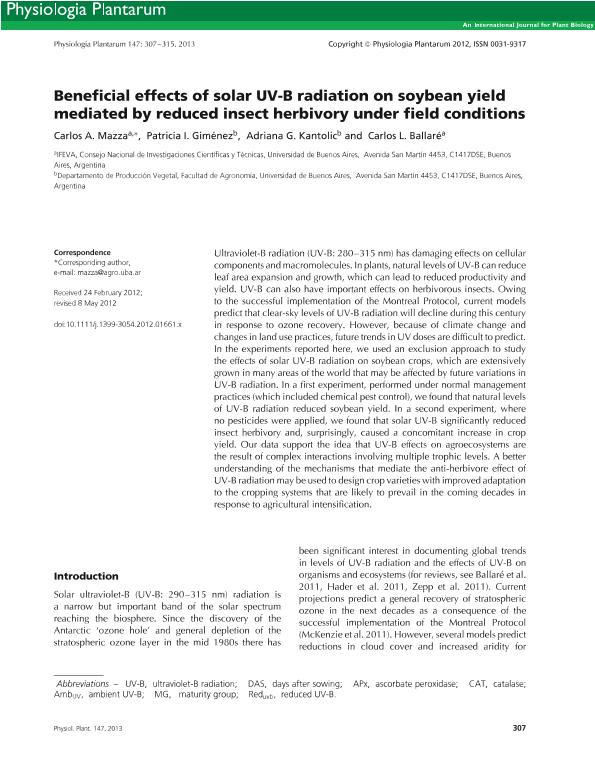Mostrar el registro sencillo del ítem
dc.contributor.author
Mazza, Carlos Alberto

dc.contributor.author
Giménez, Patricia I.
dc.contributor.author
Kantolic, Adriana Graciela
dc.contributor.author
Ballare, Carlos Luis

dc.date.available
2016-02-16T20:05:45Z
dc.date.issued
2013-05
dc.identifier.citation
Mazza, Carlos Alberto; Giménez, Patricia I.; Kantolic, Adriana Graciela; Ballare, Carlos Luis; Beneficial effects of solar UV-B radiation on soybean yield mediated by reduced insect herbivory under field conditions; Wiley; Physiologia Plantarum; 147; 3; 5-2013; 307-315
dc.identifier.issn
0031-9317
dc.identifier.uri
http://hdl.handle.net/11336/4221
dc.description.abstract
Ultraviolet-B radiation (UV-B: 280–315 nm) has damaging effects on cellular components and macromolecules. In plants, natural levels of UV-B can reduce leaf area expansion and growth, which can lead to reduced productivity and yield. UV-B can also have important effects on herbivorous insects. Owing to the successful implementation of the Montreal Protocol, current models predict that clear-sky levels of UV-B radiation will decline during this century in response to ozone recovery. However, because of climate change and changes in land use practices, future trends in UV doses are difficult to predict. In the experiments reported here, we used an exclusion approach to study the effects of solar UV-B radiation on soybean crops, which are extensively grown in many areas of the world that may be affected by future variations in UV-B radiation. In a first experiment, performed under normal management practices (which included chemical pest control), we found that natural levels of UV-B radiation reduced soybean yield. In a second experiment, where no pesticides were applied, we found that solar UV-B significantly reduced insect herbivory and, surprisingly, caused a concomitant increase in crop yield. Our data support the idea that UV-B effects on agroecosystems are the result of complex interactions involving multiple trophic levels. A better understanding of the mechanisms that mediate the anti-herbivore effect of UV-B radiation may be used to design crop varieties with improved adaptation to the cropping systems that are likely to prevail in the coming decades in response to agricultural intensification.
dc.format
application/pdf
dc.language.iso
eng
dc.publisher
Wiley

dc.rights
info:eu-repo/semantics/openAccess
dc.rights.uri
https://creativecommons.org/licenses/by-nc-sa/2.5/ar/
dc.subject
Plant-Insect Interactions
dc.subject
Agricultural Intensification
dc.subject
Crop Density
dc.subject
Glycine Max
dc.subject
Phenolic Compounds
dc.subject.classification
Ciencias de las Plantas, Botánica

dc.subject.classification
Ciencias Biológicas

dc.subject.classification
CIENCIAS NATURALES Y EXACTAS

dc.subject.classification
Agronomía, reproducción y protección de plantas

dc.subject.classification
Agricultura, Silvicultura y Pesca

dc.subject.classification
CIENCIAS AGRÍCOLAS

dc.title
Beneficial effects of solar UV-B radiation on soybean yield mediated by reduced insect herbivory under field conditions
dc.type
info:eu-repo/semantics/article
dc.type
info:ar-repo/semantics/artículo
dc.type
info:eu-repo/semantics/publishedVersion
dc.date.updated
2016-03-30 10:35:44.97925-03
dc.journal.volume
147
dc.journal.number
3
dc.journal.pagination
307-315
dc.journal.pais
Estados Unidos

dc.journal.ciudad
Hoboken
dc.description.fil
Fil: Mazza, Carlos Alberto. Universidad de Buenos Aires. Facultad de Agronomia. Departamento de Biologia Aplicada y Alimentos; Argentina. Consejo Nacional de Investigaciones Científicas y Técnicas. Oficina de Coordinación Administrativa Parque Centenario. Instituto de Investigaciones Fisiológicas y Ecológicas Vinculadas a la Agricultura; Argentina
dc.description.fil
Fil: Giménez, Patricia I.. Universidad de Buenos Aires. Facultad de Agronomia. Departamento de Producción Vegetal. Cátedra de Produccion Vegetal; Argentina
dc.description.fil
Fil: Kantolic, Adriana Graciela. Universidad de Buenos Aires. Facultad de Agronomia. Departamento de Producción Vegetal. Cátedra de Produccion Vegetal; Argentina
dc.description.fil
Fil: Ballare, Carlos Luis. Universidad de Buenos Aires. Facultad de Agronomia. Departamento de Biologia Aplicada y Alimentos; Argentina. Consejo Nacional de Investigaciones Científicas y Técnicas. Oficina de Coordinación Administrativa Parque Centenario. Instituto de Investigaciones Fisiológicas y Ecológicas Vinculadas a la Agricultura; Argentina
dc.journal.title
Physiologia Plantarum

dc.relation.alternativeid
info:eu-repo/semantics/altIdentifier/url/http://onlinelibrary.wiley.com/doi/10.1111/j.1399-3054.2012.01661.x/abstract
dc.relation.alternativeid
info:eu-repo/semantics/altIdentifier/issn/0031-9317
dc.relation.alternativeid
info:eu-repo/semantics/altIdentifier/doi/http://dx.doi.org/DOI: 10.1111/j.1399-3054.2012.01661.x
Archivos asociados
